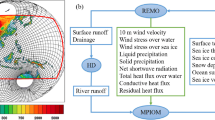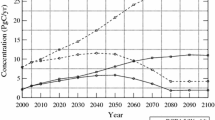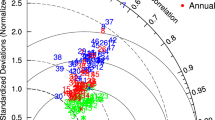Abstract
To meet the low warming targets proposed in the 2015 Paris Agreement, substantial reduction in carbon emissions is needed in the future. It is important to know how surface climates respond under low warming targets. The present study investigates the surface temperature changes under the low-forcing scenario of Representative Concentration Pathways (RCP2.6) and its updated version (Shared Socioeconomic Pathways, SSP1-2.6) by the Flexible Global Ocean-Atmosphere-Land System (FGOALS) models participating in phases 5 and 6 of the Coupled Model Intercomparison Project (CMIP5 and CMIP6, respectively). In both scenarios, radiative forcing (RF) first increases to a peak of 3 W m−2 around 2045 and then decreases to 2.6 W m−2 by 2100. Global mean surface air temperature rises in all FGOALS models when RF increases (RF increasing stage) and declines or holds nearly constant when RF decreases (RF decreasing stage). The surface temperature change is distinct in its sign and magnitude between the RF increasing and decreasing stages over the land, Arctic, North Atlantic subpolar region, and Southern Ocean. Besides, the regional surface temperature change pattern displays pronounced model-to-model spread during both the RF increasing and decreasing stages, mainly due to large intermodel differences in climatological surface temperature, ice-albedo feedback, natural variability, and Atlantic Meridional Overturning Circulation change. The pattern of tropical precipitation change is generally anchored by the spatial variations of relative surface temperature change (deviations from the tropical mean value) in the FGOALS models. Moreover, the projected changes in the updated FGOALS models are closer to the multi-model ensemble mean results than their predecessors, suggesting that there are noticeable improvements in the future projections of FGOALS models from CMIP5 to CMIP6.
摘要
为了实现2015年巴黎协定提出的低增温目标,人类社会需要在未来大量地减少碳排放量,相应的未来情景称之为低增温情景。全球表面温度在低增温背景下如何演变是气候变化中的重要问题。本文研究了在CMIP5中低强迫情景(RCP2.6)和CMIP6中相应升级的低强迫情景(SSP1-2.6)下,4个FGOALS模式预估的未来全球表面温度的变化趋势及相应机制。在RCP2.6和SSP1-2.6两种情景下,外辐射强迫(RF)都是先不断增长,在2045年左右达到3W m-2的峰值,然后在2100年下降到2.6W m-2。在4个FGOALS模式中,全球平均表面气温都是在RF增长的时候(RF上升阶段)不断上升,而在RF下降的时候(RF下降阶段)保持稳定不变或者下降。在RF上升和下降两个不同阶段,表面温度的变化符号和变化强度在陆地、北冰洋、北大西洋副极地地区和南极都有非常显著的差异。此外,表面温度变化的区域分布特征在这两个阶段则都表现出显著的模式间差异性,这主要是因为不同模式在模拟气候态表面温度、冰-反照率反馈机制、自然变率和北大西洋经向翻转环流的变化方面存在非常大的区别。在FGOALS模式中,热带降水的空间分布特征大都受表面温度相对变化(即与热带平均增温强度的偏差)的空间结构所调控。FGOALS模式在低增温情景下得到的预估结果,在CMIP6中相对于在CMIP5中更接近于多模式集合平均的结果。这表明从CMIP5到CMIP6,FGOALS模式对低增温情景下的未来预估模拟有显著提高。
Similar content being viewed by others
References
Allen, M. R., and W. J. Ingram, 2002: Constraints on future changes in climate and the hydrologic cycle. Nature, 419, 224–232, https://doi.org/10.1038/nature01092.
Andrews, T., P. M. Forster, O. Boucher, N. Bellouin, and A. Jones, 2010: Precipitation, radiative forcing and global temperature change. Geophys. Res. Lett., 37, L14701, https://doi.org/10.1029/2010GL043991.
Armour, K. C., J. Marshall, J. R. Scott, A. Donohoe, and E. R. Newsom, 2016: Southern ocean warming delayed by circumpolar upwelling and equatorward transport. Nutere Geoscience, 9, 549–554, https://doi.org/10.1038/ngeo2731.
Bao, Q., and Coauthors, 2013: The flexible global ocean-atmosphere-land system model, spectral version 2: FGOALS-s2. Adv. Atmos. Sci., 30, 561–576, 30, 561–576, https://doi.org/10.1007/s00376-012-2113-9.
Bindoff, N. L., and Coauthors, 2019: Changing ocean, marine ecosystems, and dependent communities. IPCC Special Report on the Ocean and Cryosphere in a Changing Climate, H.-O. Portner et al., Eds., In press.
Chadwick, R., I. Boutle, and G. Martin, 2013: Spatial patterns of precipitation change in CMIP5: Why the rich do not get richer in the tropics. J. Climate, 26, 3803–3822, https://doi.org/10.1175/JCLI-D-12-00543.1.
Chen, C. L., G. H. Wang, S. P. Xie, and W. Liu, 2019a: Why does global warming weaken the gulf stream but intensify the kuroshio? J. Climate, 32, 7437–7451, https://doi.org/10.1175/JCLI-D-18-0895.1.
Chen, L., X. Qu, G. Huang, and Y. F. Gong, 2019b: Projections of East Asian summer monsoon under 1.5 C and 2 C warming goals. Theor. Appl. Climatol., 137, 2187–2201, https://doi.org/10.1007/s00704-018-2720-1.
Cheng, L. J., J. Abraham, Z. Hausfather, and K. E. Trenberth, 2019: How fast are the oceans warming? Science, 363, 128–129, https://doi.org/10.1126/science.aav7619.
Chou, C., and J. D. Neelin, 2004: Mechanisms of global warming impacts on regional tropical precipitation. J. Climate, 17, 2688–2701, https://doi.org/10.1175/1520-0442(2004)017<2688:MOGWIO>2.0.CO;2.
Chou, C., J. D. Neelin, C. A. Chen, and J. Y. Tu, 2009: Evaluating the “rich-get-richer” mechanism in tropical precipitation change under global warming. J. Climate, 22, 1982–2005, https://doi.org/10.1175/2008JCLI2471.1.
Church, J. A., and N. J. White, 2011: Sea-level rise from the late 19th to the early 21st century. Surveys in Geophysics, 32, 585–602, https://doi.org/10.1007/s10712-011-9119-1.
Chylek, P., C. K. Folland, G. Lesins, M. K. Dubey, and M. Y. Wang, 2009: Arctic air temperature change amplification and the Atlantic Multidecadal Oscillation. Geophys. Res. Lett., 16, L14801, https://doi.org/10.1029/2009GL038777.
Cohen, J., and Coauthors, 2014: Recent Arctic amplification and extreme mid-latitude weather. Nature Geoscience, 7, 627–637, https://doi.org/10.1038/ngeo2234.
Drijfhout, S., G. J. van Oldenborgh, and A. Cimatoribus, 2012: Is a decline of AMOC causing the warming hole above the North Atlantic in observed and modeled warming patterns? J. Climate, 25, 8373–8379, https://doi.org/10.1175/JCLI-D-12-00490.1.
Eyring, V., S. Bony, G. A. Meehl, C. A. Senior, B. Stevens, R. J. Stouffer, and K. E. Taylor, 2016: Overview of the Coupled Model Intercomparison Project Phase 6 (CMIP6) experimental design and organization. Geoscientific Model Development, 9, 1937–1958, https://doi.org/10.5194/gmd-9-1937-2016.
Francis, J. A., and E. Hunter, 2007: Changes in the fabric of the Arctic’s greenhouse blanket. Environmental Research Letters, 2, 045011, https://doi.org/10.1088/1748-9326/2/4/045011.
Graversen, R. G., T. Mauritsen, M. Tjernström, E. Källén, and G. Svensson, 2008: Vertical structure of recent Arctic warming. Nature, 451, 53–56, https://doi.org/10.1038/nature06502.
Guo, Y. Y., Y. Q. Yu, P. F. Lin, H. L. Liu, B. He, Q. Bao, S. W. Zhao, and X. W. Wang, 2020: Overview of the CMIP6 historical experiment datasets with the climate system model CAS FGOALS-f3-L. Adv. Atmos. Sci., 1057–1066, https://doi.org/10.1007/s00376-020-2004-4.
Harris, I., T. J. Osborn, P. Jones, and D. Lister, 2020: Version 4 of the CRU TS monthly high-resolution gridded multivariate climate dataset. Scientific Data, 7, 109, https://doi.org/10.1038/s41597-020-0453-3.
He, B., and Coauthors, 2019: CAS FGOALS-f3-L model datasets for CMIP6 historical atmospheric model intercomparison project simulation. Adv. Atmos. Sci., 36, 771–778, https://doi.org/10.1007/s00376-019-9027-8.
He, B., and Coauthors, 2020: CAS FGOALS-f3-L model datasets for CMIP6 GMMIP tier-1 and tier-3 experiments. Adv. Atmos. Sci., 17, 18–28, https://doi.org/10.1007/s00376-019-9085-y.
Held, I. M., and B. J. Soden, 2006: Robust responses of the hydrological cycle to global warming. J. Climate, 19, 5686–5699, https://doi.org/10.1175/JCLI3990.1.
Held, I. M., M. Winton, K. Takahashi, T. Delworth, F. R. Zeng, and G. K. Vallis, 2010: Probing the fast and slow components of global warming by returning abruptly to preindustrial forcing. J. Climate, 23, 2418–2427, https://doi.org/10.1175/2009JCLI3466.1.
Holland, M. M., and C. M. Bitz, 2003: Polar amplification of climate change in coupled models. Climate Dyn., 21, 221–232, https://doi.org/10.1007/s00382-003-0332-6.
Huang, B. Y., and Coauthors, 2017: Extended reconstructed Sea surface temperature, Version 5 (ERSSTv5): Upgrades, validations, and intercomparisons. J. Climate, 30, 8179–8205, https://doi.org/10.1175/JCLI-D-16-0836.1.
Huang, P., S. P. Xie, K. M. Hu, G. Huang, and R. Huang, 2013: Patterns of the seasonal response of tropical rainfall to global warming. Nature Geoscience, 6, 357–361, https://doi.org/10.1038/ngeo1792.
IPCC, 2013: Climate Change 2013: The Physical Science Basis. Cambridge University Press, 1535 pp., https://doi.org/10.1017/CBO9781107415324.
IPCC, 2018: Global Warming of 1.5°C. An IPCC Special Report on the impacts of global warming of 1.5°C above pre-industrial levels and related global greenhouse gas emission pathways, in the context of strengthening the global response to the threat of climate change, sustainable development, and efforts to eradicate poverty. V. Masson-Delmotte,, et al., Eds., In Press.
Johnson, N. C., and S. P. Xie, 2010: Changes in the sea surface temperature threshold for tropical convection. Nature Geoscience, 3, 842–845, https://doi.org/10.1038/ngeo1008.
Kamae, Y., and M. Watanabe, 2013: Tropospheric adjustment to increasing CO2: Its timescale and the role of land-sea contrast. Climate Dyn., 41, 3007–3024, https://doi.org/10.1007/s00382-012-1555-1.
Keil, P., T. Mauritsen, J. Jungclaus, C. Hedemann, D. Olonscheck, and R. Ghosh, 2020: Multiple drivers of the North Atlantic warming hole. Nature Climate Change, 10, 667–671, https://doi.org/10.1038/s41558-020-0819-8.
Kim, H., and S. I. An, 2013: On the subarctic North Atlantic cooling due to global warming. Theor. Appl. Climatol., 114, 9–19, https://doi.org/10.1007/s00704-012-0805-9.
Kumar, A., and Coauthors, 2010: Contribution of sea ice loss to Arctic amplification. Geophys. Res. Lett., 37, L21701, https://doi.org/10.1029/2010GL045022.
Lambert, F. H., and M. J. Webb, 2008: Dependency of global mean precipitation on surface temperature. Geophys. Res. Lett., 35, L16706, https://doi.org/10.1029/2008GL034838.
Li, D. H., T. J. Zhou, L. W. Zou, W. X. Zhang, and L. X. Zhang, 2018: Extreme high-temperature events over east Asia in 1.5°C and 2°C warmer futures: Analysis of NCAR CESM low-warming experiments. Geophys. Res. Lett., 45, 1541–1550, https://doi.org/10.1002/2017GL076753.
Li, L. J., and Coauthors, 2013: The flexible global ocean-atmosphere-land system model, grid-point version 2: FGOALS-g2. Adv. Atmos. Sci., 30, 543–560, https://doi.org/10.1007/s00376-012-2140-6.
Li, L. J., and Coauthors, 2020: The flexible global ocean-atmosphere-land system model grid-point version 3 (FGOALS-g3): Description and evaluation. Journal of Advances in Modeling Earth Systems, https://doi.org/10.1029/2019ms002012.
Lin, P. F., H. L. Liu, Y. Q. Yu, and T. J. Zhou, 2013: Long-term behaviors of two versions of FGOALS2 in preindustrial control simulations with implications for 20th century simulations. Adv. Atmos. Sci., 31, 577–592, https://doi.org/10.1007/s00376-013-2186-0.
Long, S. M., S. P. Xie, X. T. Zheng, and Q. Y. Liu, 2014: Fast and slow responses to global warming: Sea surface temperature and precipitation patterns. J. Climate, 27, 285–299, https://doi.org/10.1175/JCLI-D-13-00297.1.
Long, S. M., S. P. Xie, and W. Liu, 2016: Uncertainty in tropical rainfall projections: Atmospheric circulation effect and the Ocean Coupling. J. Climate, 29, 2671–2687, https://doi.org/10.1175/jcli-d-15-0601.1.
Long, S. M., S. P. Xie, Q. Y. Liu, X. T. Zheng, G. Huang, K. M. Hu, and Y. Du, 2018: Slow ocean response and the 1.5 and 2°C warming targets. Chinese Science Bulletin, 63, 558–570, https://doi.org/10.1360/N972017-01115. (in Chinese with English abstract)
Long, S.-M., S.-P. Xie, Y. Du, Q. Y. Liu, X.-T. Zheng, G. Huang, K.-M. Hu, and J. Ying, 2020: Effects of ocean slow response under low warming targets. J. Climate, 33, 477–496, https://doi.org/10.1175/jcli-d-19-0213.1.
Ma, J., S. P. Xie, and Y. Kosaka, 2012: Mechanisms for tropical tropospheric circulation change in response to global warming. J. Climate, 25, 2979–2994, https://doi.org/10.1175/JCLI-D-11-00048.1.
Mann, M. E., 2009: Defining dangerous anthropogenic interference. Proceedings of the National Academy of Sciences of the United States of America, 106, 4065–4066, https://doi.org/10.1073/pnas.0901303106.
Menary, M. B., and R. A. Wood, 2018: An anatomy of the projected North Atlantic warming hole in CMIP5 models. Climate Dyn., 50, 3063–3080, https://doi.org/10.1007/s00382-017-3793-8.
Mitchell, J. F. B., C. A. Wilson, and W. M. Cunnington, 1987: On CO2 climate sensitivity and model dependence of results. Quart. J. Roy. Meteor. Soc., 113, 293–322, https://doi.org/10.1002/qj.49711347517.
Nangombe, S., T. J. Zhou, W. X. Zhang, B. Wu, S. Hu, L. W. Zou, and D. H. Li, 2018: Record-breaking climate extremes in Africa under stabilized 1.5°C and 2°C global warming scenarios. Nature Climate Change, 8, 375–380, https://doi.org/10.1038/s41558-018-0145-6.
Nie, Y., L. J. Li, Y. L. Tang, and B. Wang, 2019: Impacts of changes of external forcings from CMIP5 to CMIP6 on surface temperature in FGOALS-g2. SOLA, 15, 211–215, https://doi.org/10.2151/SOLA.2019-038.
Palter, J. B., T. L. Frölicher, D. Paynter, and J. G. John, 2018: Climate, ocean circulation, and sea level changes under stabilization and overshoot pathways to 1.5 K warming. Earth System Dynamics, 9, 817–828, https://doi.org/10.5194/esd-9-817-2018.
Pithan, F., and T. Mauritsen, 2014: Arctic amplification dominated by temperature feedbacks in contemporary climate models. Nature Geoscience, 7, 181–184, https://doi.org/10.1038/ngeo2071.
Purkey, S. G., and G. C. Johnson, 2010: Warming of global abyssal and deep Southern Ocean waters between the 1990s and 2000s: Contributions to global heat and sea level rise budgets. J. Climate, 23, 6336–6351, https://doi.org/10.1175/2010JCLI3682.1.
Qu, X., and G. Huang, 2018: Different multi-year mean temperature in mid-summer of South China under different 1.5°C warming scenarios. Scientific Reports, 8, 13794, https://doi.org/10.1038/s41598-018-32277-6.
Sanderson, B. M., B. C. O’Neill, and C. Tebaldi, 2016: What would it take to achieve the Paris temperature targets? Geophys Res. Lett., 43, 7133–7142, https://doi.org/10.1002/2016GL069563.
Schaeffer, M., W. Hare, S. Rahmstorf, and M. Vermeer, 2012: Long-term sea-level rise implied by 1.5°C And 2°C warming levels. Nature Climate Change, 2, 867–870, https://doi.org/10.1038/nclimate1584.
Schleussner, C. F., P. Pfleiderer, and E. M. Fischer, 2017: In the observational record half a degree matters. Nature Climate Change, 3, 460–462, https://doi.org/10.1038/nclimate3320.
Schweiger, A. J., R. W. Lindsay, S. Vavrus, and J. A. Francis, 2008: Relationships between Arctic sea ice and clouds during autumn. J. Climate, 21, 4799–4810, https://doi.org/10.1175/2008JCLI2156.1.
Screen, J. A., and I. Simmonds, 2010: The central role of diminishing sea ice in recent Arctic temperature amplification. Nature, 464, 1334–1337, https://doi.org/10.1038/nature09051.
Seager, R., N. Naik, and G. A. Vecchi, 2010: Thermodynamic and dynamic mechanisms for large-scale changes in the hydrological cycle in response to global warming. J. Climate, 23, 4651–4668, https://doi.org/10.1175/2010JCLI3655.1.
Serreze, M. C., A. P. Barrett, J. C. Stroeve, D. N. Kindig, and M. M. Holland, 2009: The emergence of surface-based Arctic amplification. Cryosphere, 3, 11–19, https://doi.org/10.5194/tc-3-11-2009.
Serreze, M. C., and R. G. Barry, 2011: Processes and impacts of Arctic amplification: A research synthesis. Global and Planetary Change, 77, 85–96, https://doi.org/10.1016/j.gloplacha.2011.03.004.
Sgubin, G., D. Swingedouw, S. Drijfhout, Y. Mary, and A. Bennabi, 2017: Abrupt cooling over the North Atlantic in modern climate models. Nature Communications, 8, 14375, https://doi.org/10.1038/ncomms14375.
Simmonds, I., and K. Keay, 2009: Extraordinary september arctic sea ice reductions and their relationships with storm behavior over 1979–2008. Geophys. Res. Lett., 36, L19715, https://doi.org/10.1029/2009GL039810.
Song, M. R., L. J. Li, and J. P. Liu, 2014: Sea ice simulations of FGOALS. Flexible Global Ocean-Atmosphere-Land System Model: A Modeling Tool for the Climate Change Research Community, T. J. Zhou et al., Eds., Springer, 303–309, https://doi.org/10.1007/978-3-642-41801-3_36.
Taylor, K. E., R. J. Stouffer, and G. A. Meehl, 2012: An overview of CMIP5 and the experiment design. Bull. Amer. Meteor. Soc., 93, 485–498, https://doi.org/10.1175/BAMS-D-11-00094.1.
van Vuuren, D. P., and Coauthors, 2011: The representative concentration pathways: An overview. Climatic Change, 119, 5–31, https://doi.org/10.1007/s10584-011-0148-z.
Vecchi, G. A., and B. J. Soden, 2007: Global warming and the weakening of the tropical circulation. J. Climate, 20, 4316–4340, https://doi.org/10.1175/JCLI4258.1.
Vecchi, G. A., B. J. Soden, A. T. Wittenberg, I. M. Held, A. Leetmaa, and M. J. Harrison, 2006: Weakening of tropical Pacific atmospheric circulation due to anthropogenic forcing. Nature, 441, 73–76, https://doi.org/10.1038/nature04744.
Wang, G. H., S. P. Xie, R. X. Huang, and C. J. Chen, 2015: Robust warming pattern of global subtropical oceans and its mechanism. J. Climate, 28, 8574–8584, https://doi.org/10.1175/JCLI-D-14-00809.1.
Winton, M., 2006: Amplified Arctic climate change: What does surface albedo feedback have to do with it? Geophys. Res. Lett., 33, L03701, https://doi.org/10.1029/2005GL025244.
Wu, P. L., R. Wood, J. Ridley, and J. Lowe, 2010: Temporary acceleration of the hydrological cycle in response to a CO2 rampdown. Geophys. Res. Lett., 33, L12705, https://doi.org/10.1029/2010GL043730.
Xie, S. P., C. Deser, G. A. Vecchi, J. Ma, H. Y. Teng, and A. T. Wittenberg, 2010: Global warming pattern formation: Sea surface temperature and rainfall. J. Climate, 23, 966–986, https://doi.org/10.1175/2009JCLI3329.1.
Xu, Y. Y., and V. Ramanathan, 2017: Well below 2°C: Mitigation strategies for avoiding dangerous to catastrophic climate changes. Proceedings of the National Academy of Sciences of the United States of America, 114, 10 315–10 323, https://doi.org/10.1073/pnas.1618481114.
Zelinka, M. D., T. A. Myers, D. T. McCoy, S. Po-Chedley, P. M. Caldwell, P. Ceppi, S. A. Klein, and K. E. Taylor, 2020: Causes of higher climate sensitivity in CMIP6 models. Geophys. Res. Lett., 47, e2019GL085782, https://doi.org/10.1029/2019GL085782.
Zhang, W. X., T. J. Zhou, L. W. Zou, L. X. Zhang, and X. L. Chen, 2018: Reduced exposure to extreme precipitation from 0.5°C less warming in global land monsoon regions. Nature Communications, 9, 3153, https://doi.org/10.1038/s41467-018-05633-3.
Zhou, T. J., and F. F. Song, 2014: Representative concentration pathway (RCP) projection of climate change by FGOALS. Flexible Global Ocean-Atmosphere-Land System Model: A Modeling Tool for the Climate Change Research Community, T. J. Zhou et al., Eds., Springer, 267–274.
Zhou, T. J., F. F. Song, and X. L. Chen, 2013: Historical evolution of global and regional surface air temperature simulated by FGOALS-s2 and FGOALS-g2: How reliable are the model results? Adv. Atmos. Sci., 30, 638–657, https://doi.org/10.1007/s00376-013-2205-1.
Zhou, T. J., and Coauthors, 2020: Development of climate and earth system models in China: Past achievements and new CMIP6 results. Journal of Meteorological Research, 34, 1–19, https://doi.org/10.1007/s13351-020-9164-0.
Acknowledgements
We acknowledge the WCRP Working Group on Coupled Modeling, which is responsible for CMIP, and the climate modeling groups for producing and making available their model outputs. All data are available at http://pcrndi9.llnl.gov/. This work was supported by the Natural Science Foundation of China (Grant Nos. 41706026 and 41831175), the National Key Research and Development Program of China (Grant Nos. 2017YFA0604600, 2016YFA0601804 and 2018YFA0605702), the Fundamental Research Funds for the Central Universities (Grant Nos. 2018B04814 and 2018B03114), the open fund of the State Key Laboratory of Satellite Ocean Environment Dynamics, Second Institute of Oceanography (Grant No. QNHX 1808), and the National Basic Research Program of China (Grant No. 2012CB955600).
Author information
Authors and Affiliations
Corresponding author
Additional information
Article Highlights
• Changes in surface temperature projected by FGOALS models under low warming scenarios are more consistent with the multi-model ensemble mean in CMIP6 than CMIP5.
• Responses of surface temperature to reduced radiative forcing display large spatial variations and model uncertainty.
• Large intermodel differences in projected surface temperature changes relate directly to the climatological model biases.
Rights and permissions
About this article
Cite this article
Long, SM., Hu, KM., Li, G. et al. Surface Temperature Changes Projected by FGOALS Models under Low Warming Scenarios in CMIP5 and CMIP6. Adv. Atmos. Sci. 38, 203–220 (2021). https://doi.org/10.1007/s00376-020-0177-5
Received:
Revised:
Accepted:
Published:
Issue Date:
DOI: https://doi.org/10.1007/s00376-020-0177-5




